(Download) AFCAT Question Papers - 01/2015 (Booklet Series D)
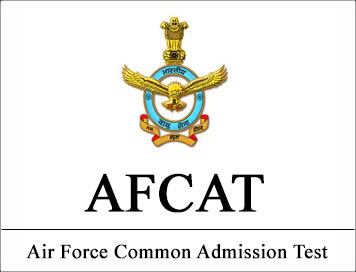
(Download) AFCAT Question Papers - 01/2015(Booklet Series D)
INSTRUCTIONS FOR CANDIDATES:
1. Total Number of Questions-100. Each Question is of three marks.
2. One mark will be deducted for every wrong answer.
3. No mark will be deducted for un-attempted questions.
4. Do not write on the Question Paper or make any mark on it.
Q1-4. Choose the word which is nearest in meaning to the given word:-
Q1. Sagacious
(a) Stupid
(b) Truthful
(c) Lustful
(d) Discerning
Q2. Pontificate
(a) To speak authoritatively
(b) To raise to higher office
(c) To act clumsily
(d) To constitute
Q3. Embellish
(a) Employ
(b) Arrange
(c) Decorate
(d) Design
Q4. Damp Squib
(a) Insignificant happening
(b) An old technique
(c) Unsuccessful attempt
(d) Short, shrill cry
Q5-8. Choose the word that best defines the given phrases:-
Q5. All agog
(a) Work helplessly
(b) Lose consciousness
(c) In a state of excitement
(d) Fall flat
Q6. Espirit de Corps
(a) Bravery
(b) Loyalty
(c) Subordination
(d) Unity
Q7. Cloak and dagger
(a) To fight to a finish
(b) To get into unexpected trouble
(c) To end the hostility
(d) Like a spy
Q8. To be at the end of one‟s tether
(a) To feel offended
(b) To draw moral attention
(c) To have no resources left
(d) To think deeply
(Ebook) AFCAT Exam Question Papers PDF
CLICK HERE FOR STUDY MATERIAL FOR AFCAT
Q9-12. Choose the correctly spelt word:-
Q9. (a) Hindrance (b) Hinderance (c) Hindrence (d) Hinderence
Q10. (a) Perjery (b) Perjury (c) Purjury (d) Perjary
Q11. (a) Reminiscene (b) Reminiscence (c) Reminicence (d) Remeniscence
Q12. (a) Omminous (b) Omineous (c) Ominous (d) Omenous
Q13-16. Choose the word which is nearly opposite in meaning to the given word:-
Q13. Sporadic
(a) Rare (b) Frequent (c) Sharp (d) Coordinated
Q14. Exonerate
(a) Reject (b) Contract (c) Accuse (d) Admit
Q15. Parsimonious
(a) Generous (b) Selfish (c) Religious (d) Hereditary
Q16. Vindicate
(a) Censure (b) Favour (c) Indicate (d) Eradicate
Q17-19. Read the following passage carefully and answer the questions given below it:-
Recently, a newspaper article mourned the total disappearance of the common house sparrow.This was a comment on the city‟s perceptible move towards edging out the flora and fauna of the city. In the rapid urbanization, multi-storied apartments grew and large scale felling of trees became necessary. Last week, however, seven pairs of these sparrows were spotted in a suburb. Possibly the greenery of this place has created a new habitat for these birds which like their proximity to human beings, and have made a comeback. A systematic development of trees and shrubs all over the city could woo the absentee house sparrow to our midst.
Q17. According to the passage, the birds have made a comeback to the suburb because they
(a) have been hunted down by the village people
(b) Love to be amidst human beings
(c) get food only where human beings live
(d) they have been deliberately brought back by biologists
Q18. In the passage the term “urbanisation” has been used to refer to
(a) the destruction of the greenery in the city
(b) construction of concrete structures on a large scale
(c) a change over from the rural life to the city life
(d) the movement of people from villages to cities
Q19. The phrase “absentee house sparrow” refers to
(a) the sparrow that makes infrequent visits
(b) the sparrow that has forgotten its habitat
(c) the sparrow that has gone away from the urban areas
(d) the sparrow that has become extinct
Q20-25 Select the most appropriate word from the options against each number:-
Watermelons ..(20).. to India by the 4th century A.D. Sushruta, the great Indian physician,….(21)…wrote Sushruta Samhit, mentions that watermelons were grown ..(22).. the banks of the river Indus. ….(23)....are also mentioned in ancient books. Sushruta calls it as Kalinda or Kalinga (hence Kalingad in Marathi). It was…(24)..to China in the 10th or 11th century and …(25)… it is grown throughout the tropics.
Q20. (a) came (b) go (c) arrived (d) started
Q21. (a) did (b) when (c) certainly (d) who
Q22. (a) above (b) outside (c) from (d) along
Q23. (a) it (b) they (c) some (d) that
Q24. (a) took (b) gave (c) taken (d) take
Q25. (a) also (b) though (c) now (d) tomorrow
Q26-29. Which word or words explains the meaning of the following idioms:-
Q26. Lay bare
(a) Expose (b) Take off all clothes
(c) Destroy (d) Exploit
Q27. A wolf in sheep‟s clothing
(a) A hypocrite (b) A wolf in woolen clothes
(c) A coward (d) A proud man
Q28. A blue stocking
(a) Stocking which is blue in colour (b) A clean cheat
(c) An unreliable person (d) a woman having literary tastes and learning
Q29. Yeoman‟s service
(a) lip-service (b) to serve like a slave
(c) to play god father (d) efficient or useful help
Q30-65. Choose the most appropriate answer:-
Q30. Which country will host the XXXI Olympic Games in 2016?
(a) Rio de Janeiro, Brazil (b) Chicago, USA
(c) Tokyo, Japan (d) Doha, Qatar
Q31. The book, “A China Passage‟ was written by
(a) MJ Akbar (b) Jagmohan
(c) Anees Jung (d) John Kenneth Galbraith
Q32. Who was the founder of Nanda dynasty?
(a) Bimbisara (b) Mahapadma Nanda
(c) Ajatasatru (d) Dhana Nanda
Q33. Which of the following books is written by Arnold Toynbee?
(a) Mankind and Mother Earth (b) Tom Sawyer
(c) The Future of Freedom (d) The Moon‟s Last Sigh
Q34. The national emblem, viz four lions standing back to back is an adaptation from which of the following:-
(a) Sarnath lions (b) Gir lions
(c) Khajurao (d) Ajanta caves
Q35. Who was the person behind conversion of East India Company from a trading company into a regional power?
(a) Lord Warren Hastings (b) Lord Clive
(c) Lord Dalhousie (d) Lord Wellesley
Q36. Who inscribed the name of Khalifa of Baghdad on his coins?
(a) Ala-ud-din Khilji (b) Iltutmish
(c) Qutub-ud-in Aibak (d) Balban
Q37. Who among the following is not a recipient of the „Bharatiya Jnanpith‟ Award?
(a) Ashapurna Devi (b) MF Hussain
(c) Raghupati Sahay (d) VK Gokak
Q38. Global 500 awards are given for outstanding achievement in which of the following fields?
(a) Population Control (b) Elimination of illiteracy
(c) Campaigning against AIDS (d) Protection of environment
Q39. Who among the following Sultans of Delhi assumed the title, „Sikandar-i-Sani?
(a) Balban (b) Ala-ud-din Khilji
(c) Muhammad-bin-Tughlaq (d) Sikander Lodhi
Q40. UN General Assembly recently declared 21st June as
(a) International Youth Day (b) International Literacy Day
(c) International Day of Yoga (d) International Day of Peace
Q41. Pulitzer Prize is awarded for outstanding work in the field of
(a) Science and Technology (b) Environmental Studies
(c) Literature and Journalism (d) International Understanding
Q42. The presidency of the UN Security Council rotates among the Council Members
(a) Every 6 months (b) Every year
(c) Every 3 months (d) Every month
Q43. The member countries of NAFTA are
(a) USA, Canada and Mexico (b) Canada and Mexico
(c) USA and Canada (d) Argentina and Brazil
Q44. Who were the contemporaries of the Gupta Kings in the south?
(a) Chola (b) Rashtrakutas
(c) Satavahanas (d) Vakatkas
Q45. Sandeep Sejwal won the Bronze medal in 2014 Asian Games in which of the following events?
(a) 200m backstroke (b) 200m freestyle
(c) 50m breaststroke (d) 50m butterfly
Q46. Mangalyan, Mars Orbiter Mission (MOM) was launched in
(a) Jan 2013 (b) Oct 2012 (c) Oct 2013 (d) Nov 2013
Q47. “Ruhr of India” known for its rich coal deposits is in the State of
(a) Uttar Pradesh (b) Jharkhand (c) West Bengal (d) Bihar
Q48. The Indian space programme began in
(a) 1961 (b) 1962 (c) 1965 (d) 1969
Q49. „Bachpan Bachao Andolan (BBA)‟, an organisation to protect the rights of children was founded by
(a) Amir Khan (b) Kailash Satyarthi
(c) Om Prakash Gurjar (d) Santa Sinha
Q50. Which of the following Subsonic missiles, test fired in October 2014 is considered India‟s answer to America‟s Tomahawk missile?
(a) Brahmos Mk-2 (b) Prahaar (c) Nirbhay (d) Agni-V
Q51. Who among the following won the World Billiards Championship held in England in October 2014?
(a) Peter Gilchrist (b) Pankaj Advani
(c) Saurav Kothari (d) None of these
Q52. The sum of ages of 4 children born at the interval of 2 years is 52. What is the age of the oldest child?
(a) 10 years (b) 12 years (c) 14 years (d) 16 years
Q53. A certain sum under compound interest, compounded annually, amounts to Rs. 5500/- in 5 years and Rs. 6050/- in 6 years. What is the rate of interest?
(a) 12 ½ % (b) 15% (c) 20% (d) 10%
Q54. Rs. 800 becomes Rs. 956 in 3 years at a certain rate of simple interest. If the rate of interest is increased by 4%, what amount will Rs. 800 becomes in 3 years?
(a) Rs 1020.80 (b) Rs 1025 (c) Rs 1052 (d) Rs 1000
Q55. A sum of money lent out at simple interest amounts to Rs 720 after 2 years and to Rs 1020 after a further period of 5 years. The sum is
(a) Rs 500 (b) Rs 600 (c) Rs 700 (d) Rs 750
Q56. Present age of X and Y are in the ratio 7:5 respectively. Four years hence, the ratio of their ages will become 11:9 respectively. What is the present age of Y?
(a) 1 year (b) 7 year (c) 5 year (d) None of these
Q57. A can do a piece of work in 20 days and B in 25 days. They work together for 5 days and then B goes away. In how many days will A finish the work?
(a) 11 days (b) 9 days (c) 20 days (d) 21 days
Q58. Two train A & B each 66 meters long run parallel to each other in the same direction. Their speeds are 50 Kmph and 30 Kmph respectively. In what time A will completely pass B.
(a) 28 Sec (b) 28.46 Sec (c) 53.46 Sec (d) 23.76 Sec
Q59. A train 77.5 m in length is running at the rate of 65 Kmph. Find the time taken by the train to pass the man walking in the same direction as the train @ 3 Kmph.
(a) 2.5 Sec (b) 4.5 Sec (c) 6.5 Sec (d) 8 Sec
Q60. Ram can row 7½ Kmph in still water. If in a river running at 1.5 Km an hour, it takes him 50 minutes to row to a place and back, how far is the place?
(a) 3.5 Km (b) 3 Km (c) 4.5 Km (d) 5 Km
Q61. A motorboat with speed 15 Kmph in still water goes 30 Km downstream and comes back. It covers the distance in 4 hours and 30 minutes. The speed of the stream in Km/h is?
(a) 4 (b) 5 (c) 6 (d) 10
Q62. Zinc and copper are melted together in the ratio 9:11. What is the weight of the melted mixture, if 28.8 kg of zinc has been consumed in it?
(a) 58 Kg (b) 60 Kg (c) 64 Kg (d) 70 Kg
Q63. A sells his goods 20% cheaper than B and 20% dearer than C. How much percentage is C‟s goods cheaper / dearer than B.
(a) 33.33% (b) 50% (c) 45.85% (d) None of these
Q64. The average of 6 observations is 12. If the 7th observation is included, the average is reduced by 1. What will be the 7th observation?
(a) 4 (b) 5 (c) 6 (d) 7
Q65. If the incomes of Ram & Shyam are in the ratio of 3:4 and their expenditures in the ratio of 4:5,find the ratio of their savings, given that Shyam saves a third of his income.
(a) 10:15 (b) 13:20 (c) 15:20 (d) 13:15
Q66-70 In each of the following questions find out the alternative which will replace the question mark.
Q66. Sadist : Injury :: ?:?
(a) Opportunist : Generosity (b) Priest : Church
(c) Dentist : Teeth (d) Thief : Robbery
Q67. Lecherous : Carnal :: ?:?
(a) Virile : Feeble (b) Diatribe : Abuse
(c) Impede : Begin (d) Sunder : Link
Q68. Cerebrum : Brain :: ?:?
(a) Aorta : Hand (b) Ligament : Blood
(c) Ventricle : Heart (d) Country : Universe
Q69. Monument : Cenotaph :: ?:?
(a) Orifice : Opening (b) Guide : Follower
(c) Protect : Protocol (d) Sponsor : Cleave
Q70. Meadow : Sheep :: ?:?
(a) Stable : Horse (b) Hay : Insect
(c) Grass : Grasshopper (d) Pasture : Cattle
Q71-75. In each of the following questions, select a figure from amongst the four alternatives, which when placed in the blank space of figure (X) would complete the pattern.
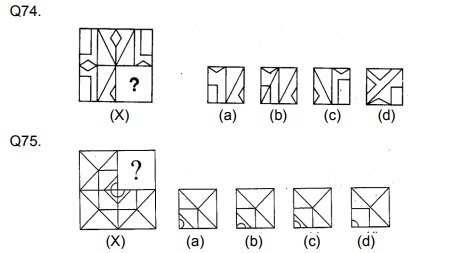
Q 76-80. Each of these questions given below contains three elements. These elements may or may not have some inter-linkage. Each group of elements may fit into one of these diagrams at (a), (b), (c) or (d). You have to indicate the group of elements which correctly fits into the diagrams.
Q76. Which of the following diagrams indicates the best relation between Biology, Zoology and Physics?
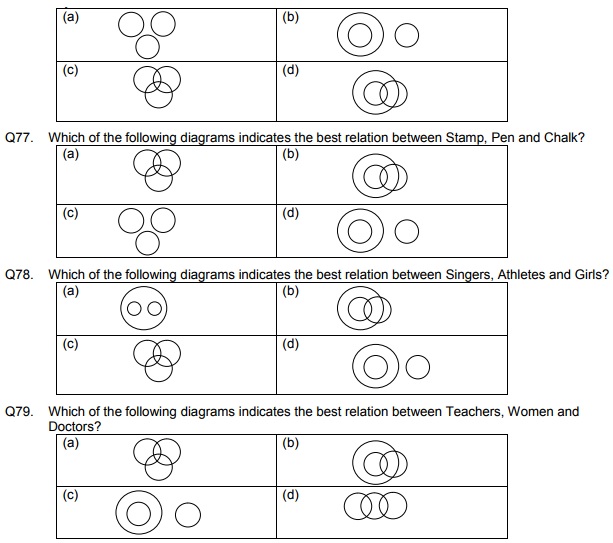

Q81-85. Each of the following questions consists of five figures marked 1,2,3,4 and 5 called the Problem Figures followed by four other figures marked a, b, c and d called the Answer Figures. Select a figure from amongst the Answer Figures which will continue the same series as established by the five Problem Figures.

Q86-90. Each of the following questions consists of two sets of figures. Figures 1, 2, 3 and 4 constitute the Problem Set while figures a, b, c and d constitute the Answer Set. There is a definite relationship between figures (1) and (2). Establish a similar relationship between figures (3) and (4) by selecting a suitable figure from the Answer set that would replace the question mark (?) in fig (4).
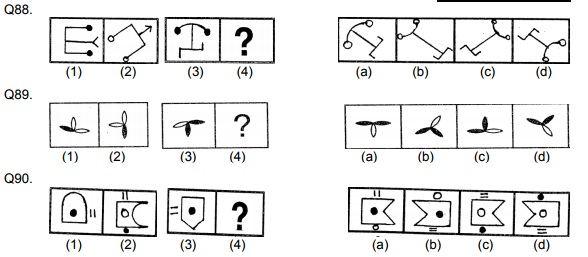
Q91-95. In each problem, out of the four figures marked (a) (b) (c) and (d) three are similar in a certain manner. However, one figure is not like the other three. Choose the figure which is different from the rest.
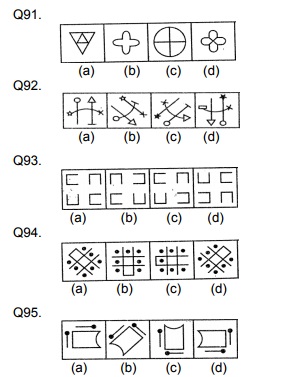
Q96-100 In each of the following questions, four words have been given out of which three are alike in some manner, while the fourth one is different. Choose the word which is different from the rest.
Q96. (a) Mendicant (b) Ascetic (c) Pious (d) Hermit
Q97. (a) Bardoli (b) Bhadravati (c) Porbandar (d) Champaran
Q98. (a) Niger (b) Suez (c) Mississippi (d) Colorado
Q99. (a) Bang (b) Hiss (c) Whistle (d) Wink
Q100. (a) Gold (b) Silver (c) Bronze (d) Iron
(Ebook) AFCAT Exam Question Papers PDF
CLICK HERE FOR STUDY MATERIAL FOR AFCAT
<< Go Back to Main Page
Courtesy: Indian Air Force



